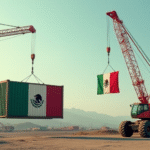Understanding State Competitiveness
State competitiveness refers to a country, region, company, or individual’s ability to compete in a given environment. In the economic and business realm, it is defined as the capability to develop and sustain competitive advantages through cost, quality, technology, or innovation, enabling a prominent and sustainable position relative to competitors.
Key Organizations and Their Perspectives
The World Economic Forum (WEF) is a significant entity concerning competitiveness. It identifies 12 pillars of competitiveness, including institutional design, infrastructure, macroeconomic environment, health, basic education, higher education, market efficiency, financial market, technology, market size, complexity factors, and added value, along with the ability to innovate.
On a local level, the Mexican Institute for Competitiveness has created a ranking of federal entities based on three indicators grouped into six sub-indices: innovation and technology, infrastructure, labor market, society and environment, rule of law, and political system and governance.
Relevance of Research Centers and Universities
Numerous research centers and prestigious universities worldwide focus on studying the factors and public policies that make countries and regions more competitive. This becomes increasingly relevant in the context of a new industrial policy in the country and how federal entities should respond to capitalize on this new policy based on Development Poles for Well-being, ultimately benefiting the most businesses and citizens through their public policies.
Public Policy Actions for Enhanced Competitiveness
Here are the public policy actions that best contribute to the competitiveness of federal entities and can serve as a guide for state governments in the current context:
- Innovation and Digitalization: Encourage the extensive use of new technologies such as artificial intelligence, the Internet of Things, and data science. Foster the creation of technology parks and specialized human capital in digital skills.
- Productive Chains Promotion: Integrate businesses of various sizes that develop logistical capabilities with economies of scale and address sectoral bottlenecks with an export perspective.
- Financing Mechanisms: Support innovative SMEs with seed capital and promote novel schemes like crowdfunding and state-level Fintech.
- Infrastructure Prioritization: Focus on efficient interconnection of transportation and telecommunications infrastructure, free from obstacles hindering safe and efficient transit. Deploy high-speed internet along highways and lagging areas.
- Environmental Sustainability: Emphasize clean energy through tax schemes and fiscal incentives, waste management, and circular economy incentives.
- Regulatory Improvement: Implement single digital windows for state procedures, simplify construction and investment permits, and combat corruption related to bureaucracy.
- Fiscal and Trade Policy: Offer temporary tax incentives linked to formal job creation and streamline export processes.
- Human Capital Development: Align educational offerings with local market needs, promote dual education programs between schools and businesses, and develop vocational training in priority sectors.
- Inter-state Coordination: Build regional focus through inter-state committees and working groups among all levels of government to implement collaboration mechanisms for timely goal achievement with minimal institutional wear and tear.
Implementation Strategy
Implementing these actions requires constructing competitiveness gap maps, prioritizing impact potential and political feasibility axes, developing evaluation indicators, and establishing monitoring mechanisms. Engage private sector partners for co-financing and collaboration on objectives, as well as facilitate societal participation through citizen audits and expert discussion forums.
Key Questions and Answers
- What is state competitiveness? State competitiveness refers to a country, region, company, or individual’s ability to compete in a given environment.
- Who are key organizations addressing competitiveness? The World Economic Forum (WEF) and the Mexican Institute for Competitiveness are significant entities addressing competitiveness.
- Why is understanding competitiveness crucial? Understanding competitiveness helps shape public policies and capitalize on new industrial strategies, ultimately benefiting businesses and citizens.
- What are the essential public policy actions for enhancing competitiveness? Key actions include fostering innovation and digitalization, promoting productive chains, improving financing mechanisms, prioritizing infrastructure, focusing on environmental sustainability, enhancing regulatory processes, implementing fiscal and trade policies, developing human capital, and coordinating inter-state efforts.






